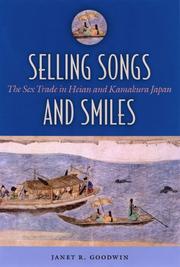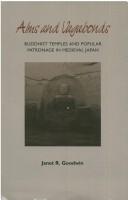| Listing 1 - 8 of 8 |
Sort by
|

ISBN: 0824830687 0824830970 9780824830687 9780824830977 Year: 2007 Publisher: Honolulu University of Hawaii press
Abstract | Keywords | Export | Availability | Bookmark
 Loading...
Loading...Choose an application
- Reference Manager
- EndNote
- RefWorks (Direct export to RefWorks)
Prostitution --- J4188 --- J4233 --- Female prostitution --- Hustling (Prostitution) --- Prostitution, Female --- Sex trade (Prostitution) --- Sex work (Prostitution) --- Street prostitution --- Trade, Sex (Prostitution) --- White slave traffic --- White slavery --- Work, Sex (Prostitution) --- Sex-oriented businesses --- Brothels --- Pimps --- Procuresses --- Red-light districts --- Sex crimes --- History --- Japan: Sociology and anthropology -- night-time entertainment, mizu shōbai, geisha, hostess, mama-san --- Japan: Sociology and anthropology -- social pathology -- prostitution --- Sex work

ISBN: 0824815475 Year: 1994 Publisher: Honolulu University of Hawaii press
Abstract | Keywords | Export | Availability | Bookmark
 Loading...
Loading...Choose an application
- Reference Manager
- EndNote
- RefWorks (Direct export to RefWorks)
Buddhism --- Buddhist giving --- Buddhist temple finance --- History
Book
ISBN: 0824864255 1441659285 Year: 2006 Publisher: Honolulu : University of Hawaii Press,
Abstract | Keywords | Export | Availability | Bookmark
 Loading...
Loading...Choose an application
- Reference Manager
- EndNote
- RefWorks (Direct export to RefWorks)
Selling Songs and Smiles explores female sexual entertainment ("songs and smiles") during Japan's Heian and Kamakura periods, examining the gradual construction of a transgressive identity ("prostitute") for women engaged in the sex trade. Over some four hundred years, the character and public image of sexual entertainment was shaped by growing restrictions on female sexual activity and increasingly negative views of the female body-themselves the result of socioeconomic change in society at large. Although it is possible to paint a picture of the general decline in the status of women in the sex trade, there were also ambiguities in how they were regarded by society in the very oldest extant references to them in historical sources. Using essays, diaries, legal documents, stories, and illustrated works, this original and distinctive study unravels social attitudes toward female sexual entertainers and examines changes in their trade and the treatment they received at the hands of the court, the bakufu, and religious institutions.Compellingly argued and stylishly written, Selling Songs and Smiles challenges several prevailing interpretations, most notably the organic connection posed by scholars between shamans and sexual entertainers. Based on her exhaustive research into multiple types of primary sources, Janet Goodwin views women involved in the sex trade neither as entirely social marginals nor artisans situated within normal societal bounds. What emerges from her study is the complex and often contradictory nature of the Heian and Kamakura discourse on sexual entertainment.
Prostitution --- History
Book
ISBN: 9780824846664 Year: 2022 Publisher: Honolulu
Abstract | Keywords | Export | Availability | Bookmark
 Loading...
Loading...Choose an application
- Reference Manager
- EndNote
- RefWorks (Direct export to RefWorks)
Book
ISBN: 9780824864255 Year: 2006 Publisher: Honolulu
Abstract | Keywords | Export | Availability | Bookmark
 Loading...
Loading...Choose an application
- Reference Manager
- EndNote
- RefWorks (Direct export to RefWorks)
Book
ISBN: 9780824872939 Year: 2018 Publisher: Honolulu University of Hawaiʻi Press
Abstract | Keywords | Export | Availability | Bookmark
 Loading...
Loading...Choose an application
- Reference Manager
- EndNote
- RefWorks (Direct export to RefWorks)
Landed estates (shoen) produced much of the material wealth supporting all levels of late classical and medieval Japanese society. During the tenth through sixteenth centuries, estates served as sites of de facto government, trade network nodes, developing agricultural technology, and centers of religious practice and ritual. Although mostly farmland, many yielded nonagricultural products, including lumber, salt, fish, and silk, and provided livelihoods for craftsmen, seafarers, peddlers, and performers, as well as for cultivators. By the twelfth century, an estate "system" permeated much of the Japanese archipelago. This volume examines the system from three perspectives: the land itself; the power derived from and exerted over the land; and the religion institutions and individuals that were involved in landholding practices.Chapters by Japanese and Western scholars explore how the estate system arose, developed, and eventually collapsed. Several investigate a single estate or focus on agricultural techniques, while others survey estates in broad contexts such as economic change and maritime trade. Other chapters look at how we learn about estates by inspecting documents, landscape features, archaeological remains, and extant buildings and images; how representatives of every social stratum worked together to make the land productive and, conversely, how cooperative arrangements failed and rivals battled one another, making conflict as well as collaboration a hallmark of the system.
Manors --- Land tenure --- History --- Japan
Book

ISBN: 082487546X 0824872932 Year: 2018 Publisher: Honolulu : University of Hawaii Press,
Abstract | Keywords | Export | Availability | Bookmark
 Loading...
Loading...Choose an application
- Reference Manager
- EndNote
- RefWorks (Direct export to RefWorks)
Landed estates (shōen) produced much of the material wealth supporting all levels of late classical and medieval Japanese society. During the tenth through sixteenth centuries, estates served as sites of de facto government, trade network nodes, developing agricultural technology, and centers of religious practice and ritual. Although mostly farmland, many yielded nonagricultural products, including lumber, salt, fish, and silk, and provided livelihoods for craftsmen, seafarers, peddlers, and performers, as well as for cultivators. By the twelfth century, an estate "system" permeated much of the Japanese archipelago. This volume examines the system from three perspectives: the land itself; the power derived from and exerted over the land; and the religion institutions and individuals that were involved in landholding practices.Chapters by Japanese and Western scholars explore how the estate system arose, developed, and eventually collapsed. Several investigate a single estate or focus on agricultural techniques, while others survey estates in broad contexts such as economic change and maritime trade. Other chapters look at how we learn about estates by inspecting documents, landscape features, archaeological remains, and extant buildings and images; how representatives of every social stratum worked together to make the land productive and, conversely, how cooperative arrangements failed and rivals battled one another, making conflict as well as collaboration a hallmark of the system. On a more personal level, we follow the monk Chōgen's restoration of Ōbe Estate and his installation of a famous Amida triad in a temple he built on the premises; the strategies of royal ladies Jōsaimon'in, Hachijōin, and Kōkamon'in as they strove to keep their landholdings viable; and the murder of estate official Gorōzaemon, whose own neighbors killed him as a result of a much larger dispute between two powerful warrior families. Land, Power, and the Sacred represents a significant expansion and revision of our knowledge of medieval Japanese estates. A range of readers will welcome the primary source research and comparative perspectives it offers; those who do not specialize in Japanese medieval history but recognize the value of teaching the history of estates will find a chapter devoted to the topic invaluable.Contributors and translators: Kristina BuhrmaMichelle DamianDavid EasonSakurai Eiji (translated by Ethan Segal)Philip GarrettJanet R. GoodwinYoshiko KainumaRieko Kamei-DycheSachiko KawaiHirota Kōji (translated by Janet R. Goodwin)Ōyama Kyōhei (translated by Janet R. Goodwin)Nagamura Makoto (translated by Janet R. Goodwin)Endō Motoo (translated by Janet R. Goodwin)Joan R. PiggottEthan SegalDan ShererKimura Shigemitsu (translated by Kristina Buhrman)Noda Taizō (translated by David Eason)Nishida Takeshi (translated by Michelle Damian)
Manors --- Land tenure --- Agrarian tenure --- Feudal tenure --- Freehold --- Land ownership --- Land question --- Landownership --- Tenure of land --- Land use, Rural --- Real property --- Land, Nationalization of --- Landowners --- Serfdom --- Dwellings --- Village communities --- History --- Japan
Book

ISBN: 9780824875466 Year: 2018 Publisher: Honolulu
Abstract | Keywords | Export | Availability | Bookmark
 Loading...
Loading...Choose an application
- Reference Manager
- EndNote
- RefWorks (Direct export to RefWorks)
No detailed description available for "Land, Power, and the Sacred".
| Listing 1 - 8 of 8 |
Sort by
|

 Search
Search Feedback
Feedback About UniCat
About UniCat  Help
Help News
News